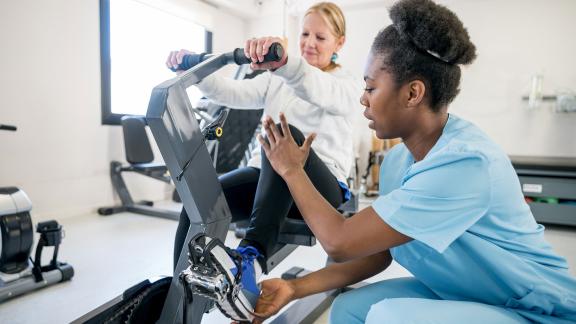Deploying nursing associates across the system: University Hospitals Plymouth NHS Trust

Overview
The nursing associate (NA) role was introduced to the NHS in 2017 as a way of bridging the gap between healthcare support workers and registered nurses.
In 2020, University Hospitals Plymouth NHS Trust (UHP) hosted a Health Education England (HEE) funded project to increase the number of trainee nursing associate apprenticeships, while developing a replicable strategy that could be shared across the Devon Integrated Care System (ICS).
Key benefits and outcomes
The trust saw substantial benefits and impressive outcomes following the increased deployment of NAs across numerous clinical settings, such as:
- Nursing-related vacancies have been reduced from 14 per cent to 2 per cent.
- UHP has successfully supported 90 training NAs so far, the latest cohort began their placements in March 2021 and recruitment is underway for the next cohort.
- Patients and their families have responded positively about the level of care provided by NAs
- Feedback suggests that patients are more likely to engage with NAs than registered nurses as NAs have more capacity and are at the bedside delivering patient-centred care. This was especially important during the pandemic when relatives and friends were not allowed to visit.
What the organisation did
The first phase of the project involved the trainee nursing associate (TNA) apprenticeships recruitment process being reviewed thoroughly. The project team undertook a benchmarking exercise to gain insight into the national entry criteria, understand placement capacity and how that would impact on the increased number of learners in the system.
The project team also supported the regional education procurement process to support the development of clear pathways that were accessible for all learners.
Following the Shape of Caring report, UHP was made a pilot site in 2017 for TNA apprentices. From this point they decided to try and grow the NA role at pace.
The trust outlined a plan of what they wanted to achieve, including:
- making a sustainable model and a replicable workforce strategy
- creating clear and accessible pathways for nursing associates from entry level
- embedding apprenticeships at all levels across the establishment, ensuring that learners from band 2 upwards become an integral part of the workforce.
And to enable this, the trust specifically wanted to focus on:
- using values based recruitment
- developing the facilitator/lead role purely for NAs
- developing a patient centred group of professionals
- Introducing NAs to areas where extra support is required.
The project focused on supporting a large cohort of 30 TNAs and implementing ‘test of change’ ratios to wards, where the number of TNAs and NAs was increased; three TNAs and one to two NAs were deployed to one surgical and one medical ward. This helped the trust to understand the impact on patient care and the teams of large numbers.
The project team undertook a quality impact assessment and agreed metrics with the teams that would be monitored, these included harm free data, patient experiences (Friends and Family Test, patient council focus groups) and close monitoring of incident management through data review. In addition, three TNAs were deployed to a triage bay of the surgical assessment ward, to work alongside registered nurses.
The project team then undertook several phenomenological studies to understand the lived experiences of the NA, TNA, teams and patients. While closely monitoring the agreed metrics to understand the added value of the role, they gained insight into deployment of roles. This consisted of:
- developing an understanding of the lived experiences of the matrons, ward managers, University of Plymouth education team and TNA/NAs (this data was gathered through questionnaires and focus groups)
- having monthly review meetings with ward managers and matrons
- garnering support and information from the Patient Council
- reviewing Friends and Family Test data
- assessing patient experiences.
Alongside this, the project team gathered vital information from across the system about elements of good practice, including where the role had been successfully integrated into key areas, such as endoscopy and A&E. This information was then shared through the Communities of Practice and reviews from the project team.
As part of the final phase, the project team worked on key elements to support with workforce redesign, workforce planning, financially viable models and a final strategy that could be shared across the system. Fundamental to the success of the project was developing an understanding of what the trust would require from its workforce in the next three to five years.
Key outcomes
- The trust is now supporting its seventh cohort with more than 90 TNAs to date in the system, with many now qualified and exploring next steps.
- There are now clear career progression options available to both trainee and qualified nursing associates.
- The trust offers more routes into the NA programme, providing opportunities for wider community participation including school leavers and external candidates.
Overcoming obstacles
The Devon healthcare system is one of the largest in the country which presented some geographical challenges in managing its workforce. Prior to the project starting, UHP had significant recruitment issues, notably a nursing vacancy rate of around 14 per cent.
UHP worked hard to raise awareness of the NA role and emphasise the benefits, especially in clinical settings. The trust worked with teams to ensure that the role was integrated and embedded in wards, ensuring value for money and laying the foundations for a sustainable model.
Some NAs initially struggled to embed themselves into the ‘test of change’ wards. However, once settled in, registered nurses reported the added value of having NAs working with them.
There were issues with finding enough financial support for factors such as extra salaries, backfilling costs and funding the protected learning time of each apprentice. The apprenticeship levy helps to cover academic costs and there is national incentive funding available too. The project team ensured that the financial modelling and integration of the role was clear across the trust.
Due to the COVID-19 pandemic, much of the information gathering and engagement (such as with patient council reps) had to been carried out virtually and although not ideal this may be the case for some time.
Despite the challenges faced, UHP is extremely positive about the future of the nursing associate role and is continuing to develop its career pathways and workforce strategy.
Take-away tips
- Identify areas that need extra support and improvement.
- Raise awareness and improve understanding of the NA role internally.
- Undertake a quality impact assessment as part of the implementation of the role and ensure that the metrics monitored reflect how the role will have added value and benefit patient care.
- Engage with your workforce to understand their concerns before developing a strategy and ensure they are kept updated though out the project.
- Consider what options there are for financial support. Where applicable use the apprenticeship levy and apply for national funding incentives.
Resources
Watch the recording of our webinar and find out how NHS trusts are using the nursing associate role across different healthcare settings.



